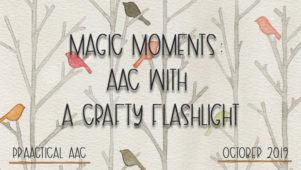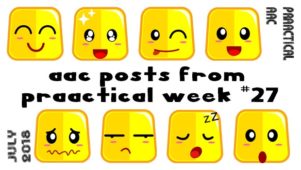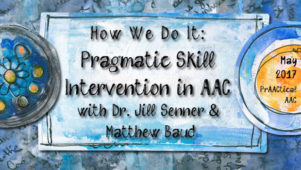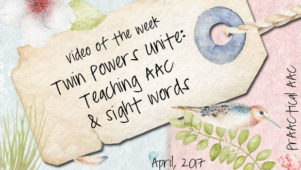PrAACtical Play: Creating Communication Opportunities with Favorite Toys

–
Guest post by Stefanie Finocchio, M.S., CCC-CF
As we’ve said before, we feel incredibly fortunate to have made our careers educating the next generation of SLPs. Sharing what we’e learned about AAC, AT, autism, literacy, and language intervention with graduate student clinicians is a challenge we both love. In this post, we share the wonderful ideas of a recent graduate, Stefanie Finocchio. Although she has only been out of grad school for a few months, Stefanie has some very prAACtical ideas about how to create communication opportunities for young children who are learning to use AAC.
–/busy%20gears.jpg)
One of my favorite “go-to” activities/games that I use frequently with my students diagnosed with autism is the Playskool Busy Gears game by Hasbro. It comes with 11 plastic gears of all different sizes and colors. Once a gear is placed on the board, you hit a button on the bottom and music plays while the gear lights up. Eventually, all the gears are on the board and simultaneously rotating and lighting up! The kids l-o-v-e the sensory input they get from this game. I can use it to target a variety of different AAC goals, such as these listed below:
–
1. Basic Requesting for Objects: I keep all the gears in a large clear jar. I made a picture symbol of an individual gear. I place this on the child’s PECs book either in isolation, with a non-preferred picture symbol item, or with multiple distracters (depending on the student’s level). The child must hand you the gear symbol each time he/she wants one to put on the game.
–
2.) Requesting “Help” or the action to “Open”: I place the gear game on the table with the tightly closed jar next to it with all the gears in it. The student goes to get a gear out of the jar but is unable to. The student must request “help” or “open” in order to get a gear out. Once the child produces the target, I help him get the gear out and then close the jar tightly again. With 11 gears to this game, I can get up to 11 trials to teach the student to request help (of course keeping in mind frustration levels!).
–
3.) Attributes: You can use this game to target colors and sizes. I typically will hold up two gears (e.g., one big orange gear and one little orange gear..it’s great how they come in pairs like this!). The student has a pre-made sentence strip that reads, “I want the ____ gear” with symbol choices “big” and “little” below it. The student must select which size he wants and read the sentence strip in order to get the gear. Or for colors, I typically hold up two of the same size gears, different colors and the student has to select the color he wants and place it on the sentence strip. For more advanced communicators, and to target sentence expansion, I have the student select both color and size (e.g., ” I want the big blue gear”).
–
4.) Commenting and Protesting: To extend on the activity, I will occasionally give the student the wrong item that he requested, and use aided language input on a communication board to model comments such as, “No!”, “I don’t want that” or “That’s not right”. You could do so much else with commenting using this game. For instance, sometimes I’ll hold the gear down while it’s rotating so it stops and model the comment, “It’s stuck!” or “Oh no!” (don’t worry..this game has proven to be VERY durable!). Other ideas for commenting are below.
–
5.) Basic Concepts/Commenting: I usually do this activity for my more advanced communicators. I’ll hide all 11 gears around the room. I have a pre-made communication board I made on Boardmaker that has the pronouns “I” and “You”, the verb “find/found”, the prepositions “in, on, under” and the nouns “gear, table, floor, desk, door, computer, box” (or whatever items are in your room) . Using aided language input, I model what I want the student to do by pointing to the icons on the board , “you” “find” “gear” as I say “I want you to find a gear!”. When the child finds one and comes back he must tell me where he found the gear using his communication board (e.g., “I” “found” “gear” “under/in/on” “desk”.). Of course, this typically requires several models/cues for the students to formulate the sentence independently, but eventually they get it. You can simplify the activity by having only one or two preposition icons if you’re really trying to hone in on the basic concepts. Or you can challenge this activity by including the color/size attributes on the board to have the student produce a sentence such as, “I found big blue gear under desk”.
–
I bought this game for about $15 on Amazon and it’s been worth every penny!
–
— — — — — — — — — — — — — — — — — — — — — — — — — — — — — — — — — — — — — — — — — —
Stefanie Finocchio graduated from Nova Southeastern University in December of 2011. She currently works for a public school district in Meriden, CT. She provides services to students from Pre-K to 5th grade, including 2 self-contained autism classes. AAC has proven to be a necessity for 16 of her students in these autism classes. “Fortunately, the classroom teachers have been amazing in understanding the demanding role of AAC,” Stefanie says. “We all work together in creating and implementing techniques to help this population learn to communicate.”
—
—
–
Filed under: Strategy of the Month
Tagged With: intervention, Magic Moments, Opportunities
This post was written by Carole Zangari





4 Comments
I love that you use this toy! I also have this toy and use it frequently in my classroom for children with ASD. I hadn’t thought about teaching the refusal by giving the wrong piece. Thank you so much for pointing that out.
Thanks for the great post. This is definitely a favorite in our toy library as well.One thing I have done to change the activity up is to have a variety of photos, pictures that the child can request to place on the central gear and comment about turning or going around etc. We have used Velcro or tape to affix the visuals.
TThat’s a great idea-will have to try that. Isn’t it funny how we have a small number of toys/materials that we keep coming back to time and time again? hanks for your comment.
After seeing this I went out and found one of these. It’s absolutely amazing!!!! I’m getting so much out of it.. so now my question is what are some other great toys like this that anyone can suggest!? I don’t have a lot of toys for really little ones